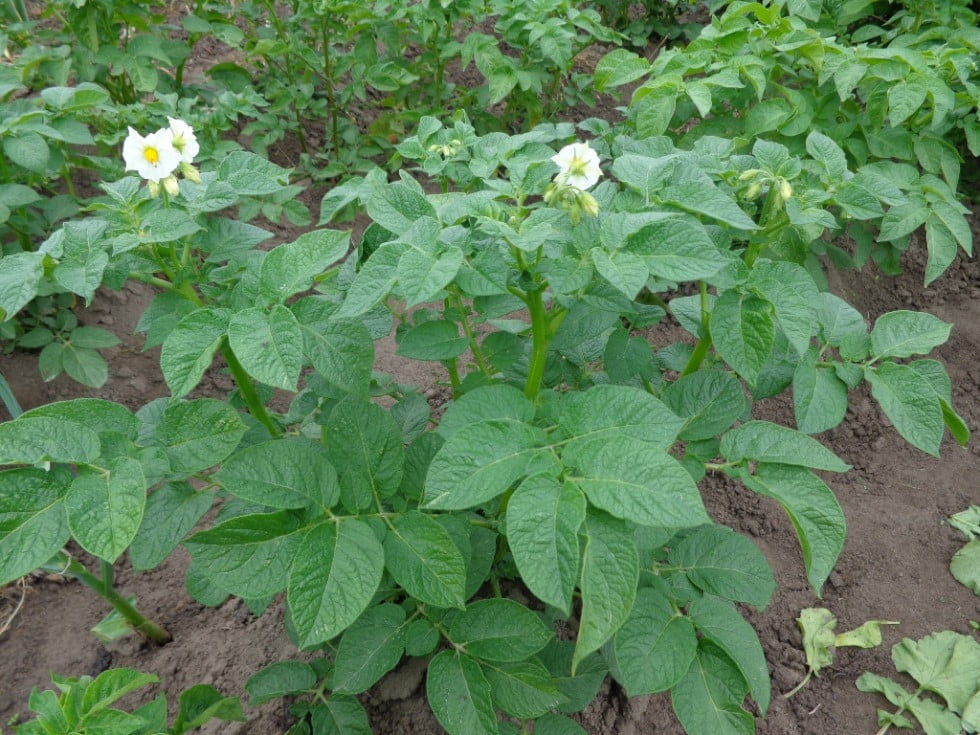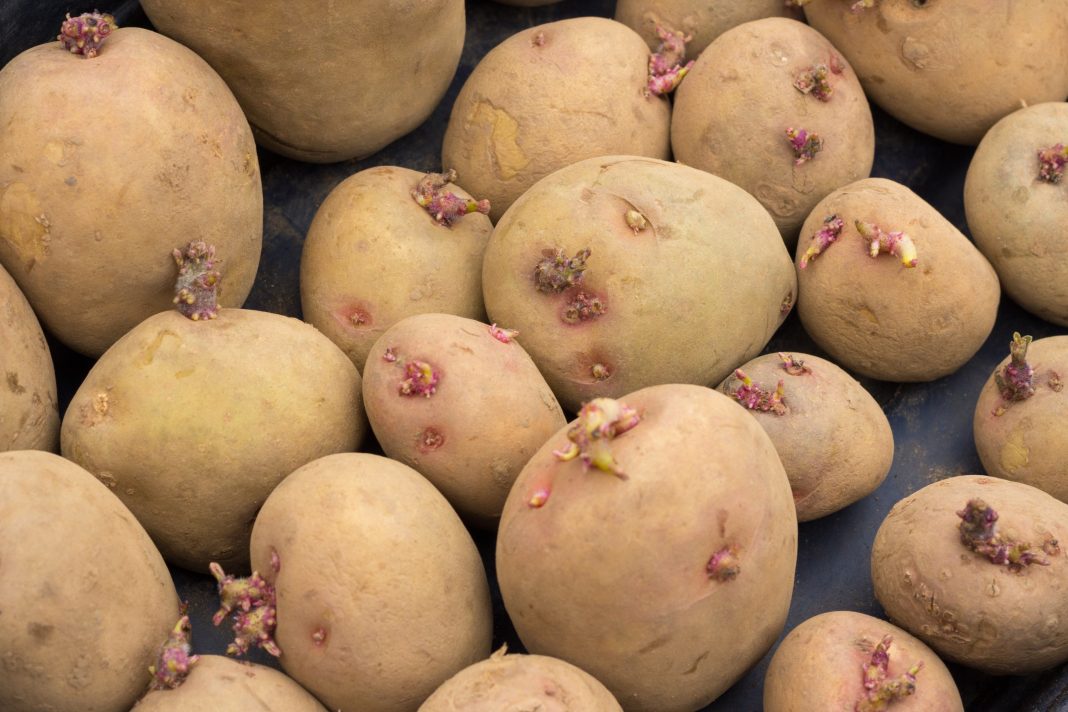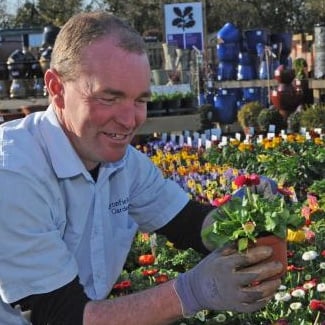Growing Amazing Potatoes
Growing potatoes can be a very rewarding experience, as potatoes are a staple in our gardens and in the British diet. By planting throughout the spring and summer, you can get ‘new’ potatoes from early summer through to late autumn, even Christmas. At The Nursery we can supply a wide selection of seed potatoes, 26 varieties to suit your particular needs. Here is some guidance on the process of growing potatoes in pots, bags and in your garden.
Chitting Potatoes
“Chitting” potatoes is a process of encouraging the seed potatoes to sprout before planting. This is done to give the potato plants a head start in terms of growth once they are planted in the soil. Chitting also has the benefit of being able to get your seed potatoes developing sooner in a frost-free environment so you can get an earlier crop. Here’s how you can chit potatoes:
Choose the Right Potatoes: Start with certified disease-free seed potatoes available from The Nursery. These are specifically grown for planting and are free from diseases that can affect potato crops.
Select a Suitable Location: Find a cool, light place to chit your potatoes. A windowsill with indirect sunlight is often ideal. You can also use an egg carton or a tray with egg cups to hold the potatoes in an upright position.
Position the Potatoes: Place the seed potatoes with the most eyes or buds facing upward. The eyes are small dimples or indentations on the surface of the potato from which the sprouts will emerge.
Allow Sprouts to Develop: Over several weeks, small sprouts (chits) will begin to emerge from the eyes of the potatoes. These sprouts are the early growth that will become the plant’s stems and leaves.
Check Regularly: Periodically check the potatoes to ensure they are not rotting. If any potatoes develop soft spots or begin to rot, remove them to prevent the spread of disease.
Planting: Once the chits are about 1-2 centimetres long, the potatoes are ready for planting. Plant them in well-draining soil, with the chits facing upwards, and cover them with a few inches of soil.
Chitting is not strictly necessary for all types of potatoes, but it can help accelerate the growth of early varieties and may result in earlier harvests. Always follow any specific guidelines provided for the particular potato variety you are planting.
Growing Potatoes In Grow Bags or pots
Potato grow bags are a popular and convenient alternative to traditional planting methods. They are a great option for those who want to grow potatoes on patios, balconies, or other small spaces particularly for individuals with limited garden space. Containers of any type are portable, easy to use, and can be stored when not in use. Here’s a guide on using pots or potato grow bags:
Choose the Right Bag or Pot: Potato grow bags, available from The Nursery, are typically made from durable, breathable fabric. They come in various sizes, but a 20 to 40 litres bag is suitable for most varieties. Ensure the bag has drainage holes at the bottom. Alternatively, any container with drainage holes will be sufficient, a large plant pot or even a bucket.
Select the Potato Varieties: Choose potato varieties that are well-suited for container growing. Compact or determinate varieties are often recommended for grow bags.
Fill the Bag or Pot: Use a high-quality potting mix, available from The Nursery, or a mix of potting soil and compost. Avoid using garden soil alone, as it may become compacted and affect drainage. Fill the grow bag or pot partially, leaving enough space to accommodate the seed potatoes and allow for hilling as the plants grow.
Chit Potatoes (Optional): You may choose to chit the potatoes before planting. This involves allowing the seed potatoes to sprout before planting which gives them a head start. (See above section on ‘chitting’).
Planting: Plant the chitted or unchitted potatoes about 4-6 inches deep in the grow bag. You can plant multiple potatoes in larger containers, but be sure to space the potatoes according to the size and planting guidelines.
Watering: Keep the soil consistently moist but not waterlogged. Since grow bags and pots can dry out faster than traditional garden soil, monitor the moisture levels regularly and adjust your watering accordingly.
Position and Sunlight: Place the grow bag or pot in a location that receives at least 6-8 hours of sunlight per day. Proper sunlight is crucial for the photosynthesis process and overall plant health.
Hilling or Earthing Up: As the potato plants grow, add more soil to cover the stems but leave the top leaves exposed. This promotes the development of more tubers and prevents them from being exposed to sunlight, which can cause them to turn green and become toxic.
Fertilizing: Apply a balanced, water-soluble fertilizer as recommended, as the potatoes grow. Container plants often require more frequent fertilization compared to those in traditional garden beds.
Harvesting: Harvest the potatoes when the plants have flowered, and the foliage begins to yellow and die back. Empty the grow bag or pot, and gently retrieve the potatoes without causing damage.
Growing potatoes in pots can be a rewarding experience, offering the advantage of easy access, efficient use of space, and better control over soil conditions. Just ensure the containers have good drainage, and you provide the necessary care for healthy potato growth.
Planting potatoes in your garden
Planting potatoes in your garden is a straightforward process that, when done correctly, can yield a bountiful harvest. Here’s a step-by-step guide:
Choose the Right Potato Varieties: Select potato varieties that suit your climate and growing conditions. There are many types of potatoes, including early, mid-season, and late varieties. Consider your local climate and the time you have available for growing.
Prepare the Soil: Potatoes prefer well-draining, loose soil with good fertility. Before planting, work the soil to remove any rocks, weeds, or debris. Consider adding organic matter like compost to improve soil structure and fertility.
Timing: Plant potatoes in early spring, a few weeks before the last expected frost date for your area. Potatoes prefer cool weather but will not tolerate frost.
Purchase Seed Potatoes: Buy certified disease-free seed potatoes from The Nursery. These are specifically grown for planting and ensure a healthy start for your potato crop.
Planting: Dig furrows or trenches in your garden bed. Place the seed potatoes with the sprouts facing up, and cover them with about 3-4 inches of soil.
Spacing: Space the seed potatoes approximately 12-15 inches apart in the row. Rows should be spaced about 2 to 3 feet apart.
Watering: Keep the soil consistently moist but not waterlogged. Watering is crucial during the growing season, especially during dry periods. However, overwatering can lead to diseases and rot.
Hilling or Earthing Up: As the potato plants grow and reach about 6-8 inches in height, start hilling soil around the plants. This involves covering the lower stems and part of the foliage with soil, leaving the top leaves exposed. Repeat the process as the plants grow, which helps prevent greening of the tubers and encourages more tuber development.
Fertilizing: Potatoes are heavy feeders. Consider applying a balanced fertilizer or adding compost (both available from The Nursery) during the growing season to ensure they receive the necessary nutrients.
Protect from Frost: If unexpected late frosts are a concern, be prepared to protect young potato plants with row covers or other protective measures.
Harvesting: Potatoes are ready for harvest when the plants flower and the foliage begins to yellow and die back. Carefully dig up the potatoes using a garden fork, being cautious not to damage the tubers.
At The Nursery we supply a broad selection of varieties including, ‘First Earlies’, ‘Second Earlies’ and ‘Main Crop’. So whatever your personal favourate spud, we are sure to be able to meet your needs. Below are the 26 varieties we have in stock right now:
| Name | Maturity |
|---|---|
| Arran Pilot | First Early |
| Caledonian Pearl | First Early |
| Cara | Maincrop |
| Casablanca | First Early |
| Charlotte | Second Early |
| Desiree | Maincrop |
| Dule of York | First Early |
| Estima | Second Early |
| Foremost | First Early |
| Gemson | Second Early |
| Kestrel | Second Early |
| King Edward | Maincrop |
| Lady Christl | First Early |
| Name | Maturity |
|---|---|
| Maris Peer | Second Early |
| Maris Piper | Maincrop |
| Nicola | Second Early |
| Pentland Javelin | First Early |
| Picasso | Maincrop |
| Pink Fir Apple | Maincrop |
| Red Duke of York | First Early |
| Rocket | First Early |
| Sagitta | Second Early |
| Sarpo Mira | Maincrop |
| Saxon | Second Early |
| Swift | First Early |
| Wilja | Second Early |
| Variety | Maturity |
|---|---|
| Arran Pilot | First Early |
| Caledonian Pearl | First Early |
| Cara | Maincrop |
| Casablanca | First Early |
| Charlotte | Second Early |
| Desiree | Maincrop |
| Dule of York | First Early |
| Estima | Second Early |
| Foremost | First Early |
| Gemson | Second Early |
| Kestrel | Second Early |
| King Edward | Maincrop |
| Lady Christl | First Early |
| Maris Peer | Second Early |
| Maris Piper | Maincrop |
| Nicola | Second Early |
| Pentland Javelin | First Early |
| Picasso | Maincrop |
| Pink Fir Apple | Maincrop |
| Red Duke of York | First Early |
| Rocket | First Early |
| Sagitta | Second Early |
| Sarpo Mira | Maincrop |
| Saxon | Second Early |
| Swift | First Early |
| Wilja | Second Early |
Final words from Matt
By following the above steps and providing proper care throughout the growing season, you can enjoy a successful potato harvest in your garden or from containers if you have insufficient space. So lets get growing. Pop along to The Nursery for advice and to pick up your seed potatoes, pots, grow bags, compost and fertilizer to benefit from the unique flavour of home-grown veg.
Matt
The Nursery Garden Centre near Trowbridge is owned and operated by Matthew Webb, a professional horticulturist . Matthew built it from scratch and loves his job, his staff and his customers. Plants are his passion and he adores growing, nurturing and knowing as much as possible about them and then passing on his expert knowledge to staff and customers.




